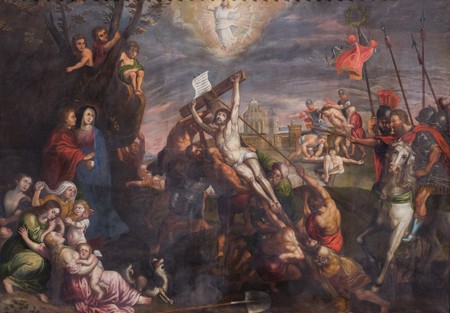In the cathedral of Cuzco,
In Cuzco, the capital of the Inka Empire before the Spanish conquest, the print likely functioned as part of a contractual agreement between the artist and the patron of the Rubens copy. As contracts from the period attest, painters were routinely directed to produce paintings that conformed to prints they were given. This practice stretched across Latin America: a patron supplied a print to an artist who was obligated to reproduce its forms in a different scale and medium to create works of art that I call, in this project, “conforming copies.”
The European print was one of the most important factors in shaping the artistic landscapes of the Spanish Americas. In the colonial period, European prints flooded the colonies (or viceroyalties) of the New World; and today Latin American churches and museums are filled with paintings that are copied, in part or whole, from these sources. My dissertation, which I completed and submitted this year while in residence at CASVA, uses this transatlantic frame both to reassess how works of art relate to one another across geographic distances and cultural divides and to rethink the terms through which early modern authorship has been understood: originality, invention, replication, and slavish copying. At the nexus of these terms
This project interrogates the local contexts in which prints circulated and the complex ways in which they came to matter for individual artists. I focus on works of art in both Mexico and Peru made from prints by Rubens, the famed painter of the Southern Netherlands who has come to define the standards by which art historians understand the status of painters and the parameters of authorship during the early modern period. In my dissertation, Rubens, the consummate authorial “genius” of Europe’s early modernity, becomes a lens through which to understand the much greater range of artists—from comparably famous painters to anonymous craftsmen—who reconstituted his printed compositions in paint and stone across the Atlantic. Similarly, his European patrons and followers become counterpoints to those who received these prints and commissioned copies of his work across space and time.
From today’s scholarly perspective, strange and surprising things happened to “Rubens” in the New World. Artists born in the Americas imagined him and his work in unusual ways, modeling their own practices on a Europe they knew only in black and white. His compositions could be repeated so often that they lost their connection to Rubens altogether, becoming prototypical colonial works of art. Having shed Rubens, his compositions could even become miracle-working. Looking closely at the specificities of conforming copies—artists, patrons, religious orders, architectural contexts—allows an exploration of what such works of art meant both for those who produced and for those who saw them, and thus recaptures something of the lived experience of using prints and viewing the works of art that were made from them in colonial Latin America.
